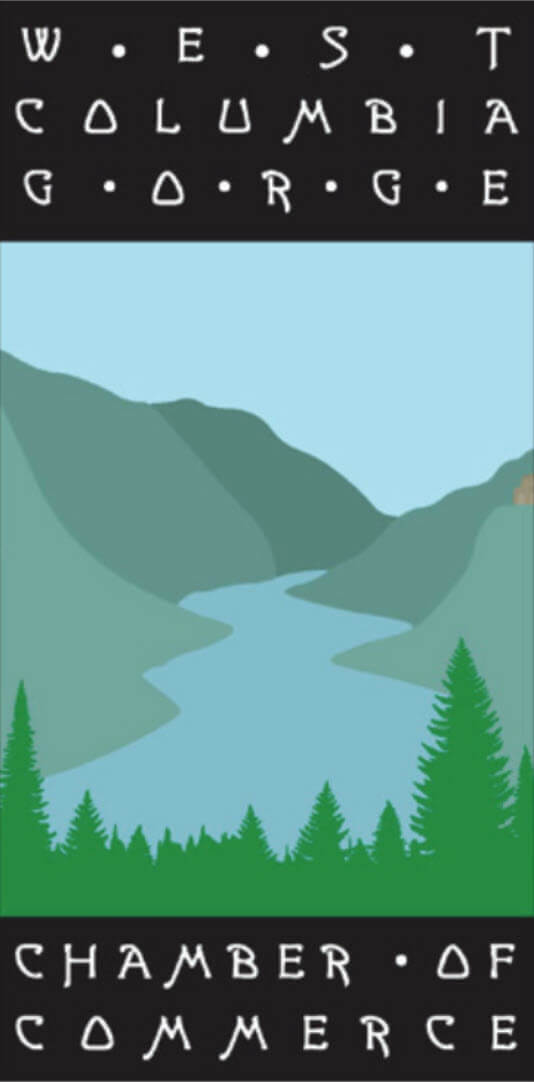Known for great hikes to scenic vistas and commanding waterfalls, the Columbia River Gorge can also be enjoyed exclusively by car. The Historic Columbia River Highway Scenic Byway is a famous driving route, which takes you through the Gorge, leading you through much of the splendor and scenery that the Columbia River Gorge has to offer. Travel Oregon offers this guide for a driving tour through the Gorge, something that can be enjoying if you are a local wanting a drive for the day, or if you are hosting guests from out of town.
Troutdale and the Sandy
To begin your journey from Portland, take Interstate 84 east to exit 17. Follow the signs through the quaint town of Troutdale and over the Sandy River to the Historic Columbia River Highway. In 1805, Lewis and Clark camped along the banks of the Sandy, which ran gritty with ash from the 1802 eruption of volcanic Mount Hood. The road follows the Wild and Scenic Sandy River for several miles, then climbs past orchards and blueberry fields through the communities of Springdale and Corbett, offering glimpses of snow-capped Mount Hood.
Gorgeous Vistas from Crown Point
At the Portland Women’s Forum State Scenic overlook at Chanticleer Point, you get your first glance of the Columbia River and the Gorge: this is the vista that inspired the Highway’s founding father, Sam Hill. The stone guard walls and graceful arches are typical of the highway’s exquisite craftsmanship. The Vista House at Crown Point is an Oregon treasure, one of the most photographed and recognizable in the Columbia River Gorge. Built as a memorial to Oregon pioneers, it offers an inspiring view of the Gorge and the mountains of the Cascade Range.
Unforgettable Falls
To help motorists navigate the 600-foot vertical drop from Crown Point, Lancaster engineered a series of what’s known as “figureeight loops” that gracefully wind down toward the river. You’re soon surrounded by mossy tree limbs, the greenery enhanced by a series of remarkable waterfalls in the next five miles: Latourell, Shepperd’s Dell, Bridal Veil, and Wahkeena. Soon you’ll reach the granddaddy of Columbia Gorge waterfalls—620-foot Multnomah Falls. Only three waterfalls in the nation are taller—and none is more beautiful. A trail from Multnomah Falls Lodge (built in 1925 and listed in the National Register of Historic Places) takes you to the lower cascade, then zigzags to the top. A little farther down the road, Horsetail Falls plummets close enough to the road to mist your windows. Before the Byway joins Interstate 84, at the community of Dodson, you’ll pass Oneonta Gorge, a botanical paradise with more than 50 species of plants that flourish in the damp, cool environs.
Bonneville Dam to Hood River
For the next 25 miles, you’ll leave the Historic Highway for modern—yet still beautiful—Interstate 84. The Gorge’s dramatic geologic formations are a highlight of this segment. Engineering and fishing buffs will want to visit the Bonneville Dam, the first structure to restrain the mighty Columbia. In nearby Cascade Locks, travelers can leave the car for a sternwheeler cruise of the Columbia. More intrepid watersports enthusiasts will want to take to the Columbia at Hood River. Here, the Gorge acts as a wind tunnel to create consistent breezes that have made this once sleepy orchard town the unofficial windsurfing capital of the world.
From Mosier to the community of Rowena
In the 12 miles from Hood River to Mosier, you’ll notice a dramatic change in the scenery. It’s here that the “two Oregons” meet. As you reach Mosier and the the second leg of the Historic Columbia River Highway (off exit 76), the moist and lush western Gorge gives way to dry, eastern Columbia River plateau. Once a booming trade center, Mosier is still famous for its springtime blossoms, fat juicy cherries, and the community’s unrivaled passion for native plants. Just west of Mosier, you can walk or bike the Historic Columbia River Highway State Trail through the restored Mosier Twin Tunnels and on to Hood River. Elegant Mayerdale Estate appears unexpectedly on this rural stretch of the road. Look for Memaloose Island in the Columbia, a traditional burial site of Native American peoples of the Columbia Basin that was partially flooded following the construction of Bonneville Dam. Farther east, be sure to linger at the viewpoint at Rowena Crest, which affords sweeping Gorge views rivaling those of Crown Point, and access to the wildflower wonders of Tom McCall Preserve.
The Dalles
The Historic Columbia River Highway spans the extremes of Oregon’s landscape, from the damp and mossy western beginning along the banks of the Sandy River to the dry oak savannahs skirting Chenoweth Creek near the historic The Dalles. The Dalles was long a Native American gathering place and is rich in Oregon Trail lore. Before you leave the Historic Highway as you enter The Dalles, you’ll find the Columbia Gorge Discovery Center and Wasco County Historical Museum. Built as the interpretive center for the National Scenic Area, the Discovery Center has answers to all your questions about the Gorge’s history. At the Museum, you’ll learn about the earliest inhabitants and hear tales of the traders and settlers who came later. As your tour over the Historic Columbia River Highway comes to a close, consider beginning a new journey to the Lewis and Clark campsite at Rock Fort.
SRC: Read the full article about this historic route here: traveloregon.com/trip-ideas/scenic-byways/the-historic-columbia-river-highway/
Photo SRC: www.wallpaperup.com/17663/Multnomah_Falls_Columbia_River_Gorge_Oregon_
waterfall_autumne.html
Looking for lodging near the Columbia River Gorge? Check out Lodging Here

